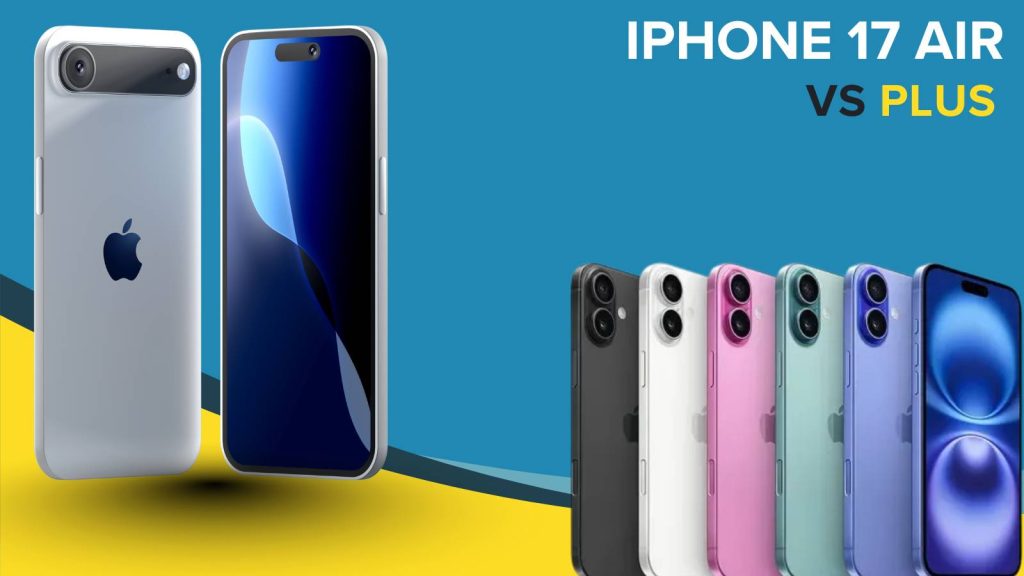Comparison of iPhone 17 Air vs Plus ultimately reveals a broader narrative about Apple’s long-term vision. As rumors swirl in the tech world, one of the most talked-about potential changes in Apple’s 2025 iPhone lineup is the introduction of the iPhone 17 Air. This new model is widely expected to replace the existing Plus model, signaling a strategic move by Apple to refresh its mid-tier smartphone category with a new identity.
The “Air” name, familiar to users of MacBook Air and iPad Air, suggests a thinner, lighter, and more minimalist version of the base iPhone, designed to fill the gap between standard and Pro models without the confusion that has surrounded the “Plus” naming.
A New Era: What Is the iPhone 17 Air?
The iPhone 17 Air is widely rumored to be Apple’s new mid-tier iPhone, positioned to replace the Plus model with a lighter, thinner, and more ergonomically refined device. Instead of merely being a “bigger base model,” the Air label implies a design-first approach—a device that emphasizes portability, comfort, and clean aesthetics without straying too close to the iPhone Pro family’s price or feature set. If Apple follows its playbook from the MacBook Air and iPad Air, expect a product that feels premium, fast, and thoughtfully balanced, but avoids the cost-driving extravagances (like the very best camera modules or exotic materials) reserved for Pro devices.
Importantly, the Air branding instantly communicates what the product prioritizes—thinness, weight, and practicality—something the “Plus” label never really did. That alone could make the iPhone 17 Air easier to market and easier for consumers to understand at a glance.
Understanding Apple’s Rumored Rebranding Strategy
Apple’s naming schemes are never accidental. Moving from “Plus” to “Air” signals a recalibration of the entire iPhone ladder. The “Plus” suffix historically meant “the same, but bigger.” In 2025, that philosophy feels dated because screen-size is no longer the only decision variable for buyers. Users now consider weight, battery longevity, camera versatility, portability, AI features, and display technology as equally (or more) important.
By leaning on the well-established Air identity—light, thin, capable—Apple can unify its messaging across devices. This alignment helps Apple simplify upgrades (“If you like your iPad/MacBook Air, the iPhone Air is your phone”) and could encourage ecosystem stickiness by offering a consistent mid-tier experience across product categories.
Expected Design, Display Size, and Weight Differences
Rumors point to a 6.6-inch display for the iPhone 17 Air—slightly smaller than the 6.7-inch canvas on current Plus and Pro Max models but still generously large for media and productivity. Expect thinner bezels and a notably slimmer chassis, potentially making it the thinnest large-screen iPhone Apple has ever shipped.
- Materials: Apple may continue using aluminum for the frame (cheaper and lighter), rather than titanium, which is likely to stay reserved for Pro models.
- Refresh rate: The biggest unknown is whether Apple finally brings 120Hz LTPO (ProMotion) to the Air. If it sticks to 60Hz to differentiate it from the Pros, the Air may still use LTPO for power efficiency but be capped at 60Hz—though an adaptive 90Hz middle ground is also possible and would be a strong selling point.
- Weight: Expect a meaningful drop versus the Plus. Even a 10–15% weight reduction can make a large-screen device feel dramatically more manageable for one-handed use.
- Ports & Buttons: USB‑C is a given. The new Capture Button (rumored for the iPhone 16 line) could carry forward, and Apple may continue experimenting with tactile engine-based solid-state buttons for durability and improved ingress protection.
How the “Air” Branding Aligns with Apple’s Existing Ecosystem
“Air” already stands for the sweet spot between base and Pro: more performance and better design than entry-level, without the Pro tax. With an iPhone 17 Air, Apple is crafting a cohesive mental model for customers:
- MacBook Air: Light but powerful enough for most.
- iPad Air: Slim, modern, and perfect for mainstream users.
- iPhone 17 Air: A thinner, lighter, still-powerful iPhone for people who don’t need Pro cameras or the highest frame-rate display.
This coherence is marketing gold and drives simpler, clearer decision trees for buyers: Base (value), Air (balanced, design-forward), Pro (performance), and Pro Max (ultimate everything).
Why the iPhone Plus Model Is Losing Relevance
Sales Performance and User Feedback on the Plus Lineup
The Plus line never achieved the same pull as the Pro/Pro Max duo. Buyers often either saved money with the base iPhone or splurged on Pro features. The Plus, lacking Pro-grade cameras, premium materials, and unique tech, felt like a stretched base model with a higher price, but not enough additional value. This consumer perception is a key pressure point that the iPhone 17 Air can fix.
Market Overlap with Pro Models and Consumer Confusion
The Plus’s screen parity with the Pro Max invited inevitable comparisons, and it consistently lost on performance, cameras, and build quality. The Air label avoids this head-to-head by defining its own value proposition: not to be the largest, not to be the most powerful, but to be the lightest, best-balanced “big-enough” iPhone.
Changing Trends in Smartphone Screen Preferences
Consumers are increasingly aware of hand ergonomics, pocketability, and long-term comfort, particularly as phones cross the 200g mark. The “biggest screen or bust” era is fading. Buyers want bigger than base, but lighter than Pro Max—the iPhone 17 Air could thread that needle perfectly.
Strategic Reasons Behind the Shift to “Air”
The Power of Branding: From iPad Air to iPhone Air
“Air” is already a trusted shorthand in Apple-speak for “light, modern, capable.” Leveraging that familiarity lets Apple sell the concept faster: consumers immediately understand what the iPhone 17 Air is aiming to be. It’s smart semantic engineering.
Targeting New Demographics with a Lighter, Thinner Model
Students, creators on a budget, travelers, and users with smaller hands who still want a large-ish screen without the fatigue are prime targets. In many global markets, weight and comfort rank higher than having the absolute best zoom lens or ProRes video.
Simplifying the iPhone Lineup for Better User Clarity
A clean 4-step ladder—iPhone 17, iPhone 17 Air, iPhone 17 Pro, iPhone 17 Pro Max—makes the buying journey clearer and reduces friction at retail. It also helps Apple position AI and camera features strategically across tiers without the “Why doesn’t the Plus have X?” discourse.
How the iPhone 17 Air Could Fit into the 2025 Lineup
Predicted Lineup: iPhone 17, 17 Air, 17 Pro, 17 Pro Max
This stack finally offers logical identities:
- iPhone 17: Value, mainstream.
- iPhone 17 Air: Design-forward, thin-and-light, “premium-but-not-Pro.”
- iPhone 17 Pro: Performance and pro-grade cameras for enthusiasts.
- iPhone 17 Pro Max: Everything the Pro has, but bigger battery, biggest screen, and possibly exclusive camera modules.
Potential Pricing Tiers and Market Positioning
Expect the iPhone 17 Air to start $100–150 above the base iPhone 17. A hypothetical US pricing matrix might look like:
- iPhone 17: $699–$749
- iPhone 17 Air: $799–$849
- iPhone 17 Pro: $999
- iPhone 17 Pro Max: $1,199+
This gives Apple room to upsell Air buyers with higher storage options while maintaining clear space under the Pro.
Performance Features: What to Expect Inside the “Air”
- Chipset: Likely an A18 (or A19 if Apple advances the naming with the entire line), tuned for efficiency.
- RAM/Storage: 8GB RAM could become the new mid-tier baseline; 128/256/512GB tiers likely.
- Battery: Slightly smaller than Plus, but efficiency gains in silicon and display tech could level out real-world battery life.
- Cameras: A dual-camera system with advanced computational photography. A 48MP wide sensor inherited from recent generations is plausible, with improved sensor crop for 2x lossless shots. Ultra-wide stays, telephoto likely reserved for Pros.
- AI & On-Device ML: Expect Apple to highlight on-device AI features—summaries, transcription, smarter Siri—made more efficient by the new Neural Engine. Apple Silicon’s ML edge becomes even more important as privacy-forward AI differentiates the platform.
iPhone 17 Air vs. iPhone 15/16 Plus: Key Differences
Here’s where iPhone 17 Air vs Plus gets concrete:
Design and Size Comparison
- Air: Slimmer chassis, lighter body, possibly redesigned curvature for better grip.
- Plus: Bulkier, heavier, and visually less distinct from the base model.
- Result: The Air will feel meaningfully different, not just look incrementally bigger.
Weight, Battery Life, and Performance Trade-offs
- Weight: Air wins, hands down. Apple will almost certainly advertise the gram reduction.
- Battery: The Plus’s key advantage was capacity. The Air might have less mAh, but chip and display efficiency could keep screen-on time competitive for typical mixed-use workloads.
- Performance: Expect a newer SoC and more AI-forward features to make the Air feel faster in real-world tasks, even if peak GPU isn’t Pro-class.
Why Users Might Prefer the Air Over the Plus
- Clarity of purpose: Air is a thoughtfully calibrated product, not an awkwardly scaled one.
- Ergonomics: Day-long comfort and portability.
- Brand association: “Air” means something positive to Apple fans; “Plus” just means “bigger.”
- Future-proofing: Newer SoC + likely better Neural Engine = longer OS and feature support runway.
Consumer Reactions & Industry Expert Opinions
What Early Leaks and Analysts Are Saying
Analysts see this as Apple cleaning up a messy middle and tightening the story around each tier. The mid-tier has been Apple’s most ambiguous space for years, and an “Air” is the most Apple-like solution: reposition, rebrand, refine.
How Longtime Apple Fans View the Change
Some traditionalists may miss the familiar “Plus” name, but many are already expressing enthusiasm for a truly lightweight big iPhone. If Apple nails weight, battery, and price, the iPhone 17 Air could become the default pick for non-Pro buyers.
Social Media Buzz: Air vs. Plus Debates
Expect “iPhone 17 Air vs Plus” trend pieces, spec comparisons, CAD-based renders, and durability debates to dominate the pre-launch chatter. If render leaks show a notably thinner silhouette—think iPad Air energy—the buzz will amplify fast.
Extra Angles Worth Watching
Sustainability & Materials
Apple is increasingly vocal about carbon-neutral goals and recycled materials. The iPhone 17 Air might lean into post-consumer recycled aluminum, smaller packaging, and improved repairability messaging (paired with Apple’s expanding Self Service Repair program).
Resale & Upgrade Cycles
The Air label could improve resale value versus the Plus by simply being desirable by design. If it becomes the “default mainstream iPhone,” demand in the secondary market will rise, stabilizing depreciation curves.
Competitor Check
- Google Pixel 9/9a XL: AI-first marketing may push Apple to visibly showcase on-device AI on the Air to prevent it feeling “too safe.”
- Samsung Galaxy S25 / FE: Price-aggressive, large-screen alternatives with high refresh rates could challenge the Air if Apple sticks to 60Hz.
FAQs
1. What is the iPhone 17 Air and how is it different from the Plus model?
The iPhone 17 Air is rumored to be a lighter, thinner, and more premium-feeling version of the current Plus model. It’s expected to offer the same large screen but with a slimmer build, refined design, and possibly better battery efficiency or display technology. The Air branding aligns with Apple’s other “lightweight” devices like the MacBook Air and iPad Air.
2. Why is Apple replacing the Plus model with the iPhone 17 Air?
The Plus model has seen declining popularity in recent years, with many users either opting for the standard or Pro versions. Apple appears to be simplifying its lineup while enhancing brand appeal by using the “Air” label, which suggests a balance of performance and portability — a move that aligns better with Apple’s overall product ecosystem.
3. Will the iPhone 17 Air be smaller than the Plus model?
No, the iPhone 17 Air is expected to retain the same display size as the Plus model (likely 6.7 inches) but will be slimmer, lighter, and easier to hold. The Air model may also use advanced materials to reduce weight without sacrificing performance or screen size.
4. Will the iPhone 17 Air have better performance than the Plus model?
Yes, most likely. Apple generally upgrades internal components with each generation. The iPhone 17 Air is expected to include a newer A-series chip, possibly better battery optimization, and improved AI or camera features. However, it may not match the performance level of the Pro models.
5. Will the iPhone 17 Air cost more than the Plus model?
While pricing hasn’t been confirmed, the iPhone 17 Air may carry a similar or slightly higher price tag than the current Plus model due to its upgraded design and branding. Apple may position it between the base and Pro models to appeal to users who want a premium feel without paying Pro prices.
6. What’s the advantage of calling it “Air” instead of “Plus”?
The “Air” name aligns with Apple’s existing strategy of lightweight, high-efficiency products like the MacBook Air and iPad Air. It instantly signals a thinner, more refined experience. In contrast, “Plus” feels outdated and vague in today’s branding environment.
7. Will the iPhone 17 Air have the same camera setup as the Plus model?
Early reports suggest the iPhone 17 Air may include a dual-camera system like the current Plus, but with enhancements in image processing and possibly AI-assisted photography. While it won’t match the Pro series, it will likely outperform the Plus in real-world use.
8. Is the iPhone 17 Air replacing the Mini or the Plus?
It’s replacing the Plus. Apple discontinued the Mini due to poor sales, and now the Plus is underperforming in the lineup. The iPhone 17 Air is expected to offer a fresh take on large-screen iPhones for users who don’t need Pro-level specs.
9. When is the iPhone 17 Air expected to be released?
Based on Apple’s usual schedule, the iPhone 17 Air would likely be announced in September 2025 alongside the full iPhone 17 lineup. Production rumors suggest Apple is already preparing for a major design update across the range.
10. Should I wait for the iPhone 17 Air or buy a Plus model now?
If you value a lighter, more modern design and want the latest features, it may be smart to wait for the iPhone 17 Air. However, if you need a new phone now and prefer a larger screen, the iPhone 15 or 16 Plus still offers great value.




